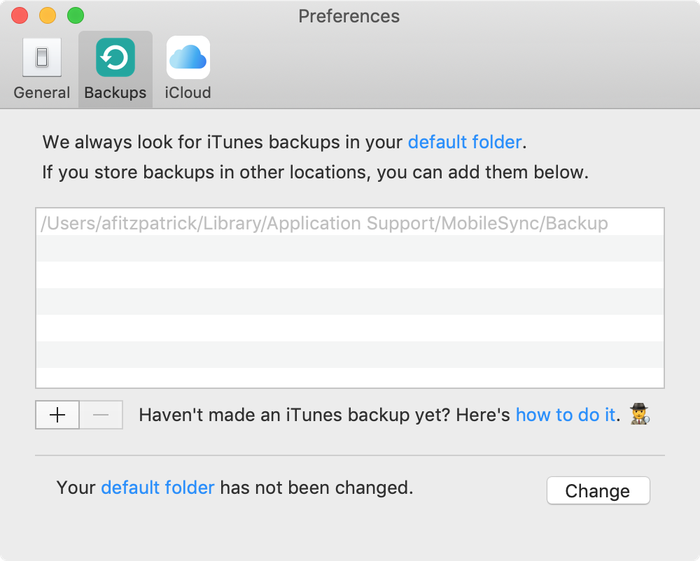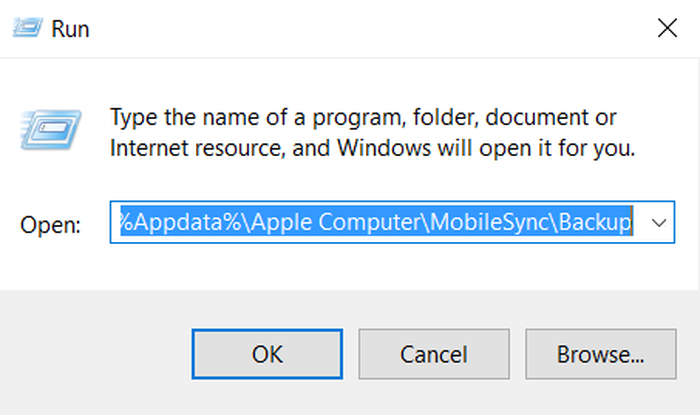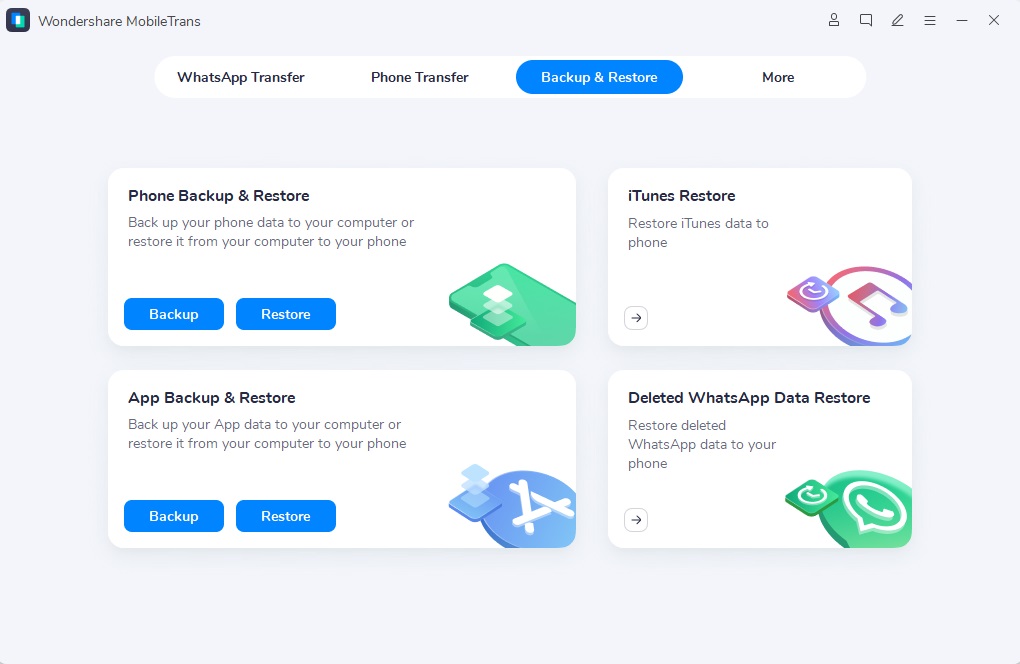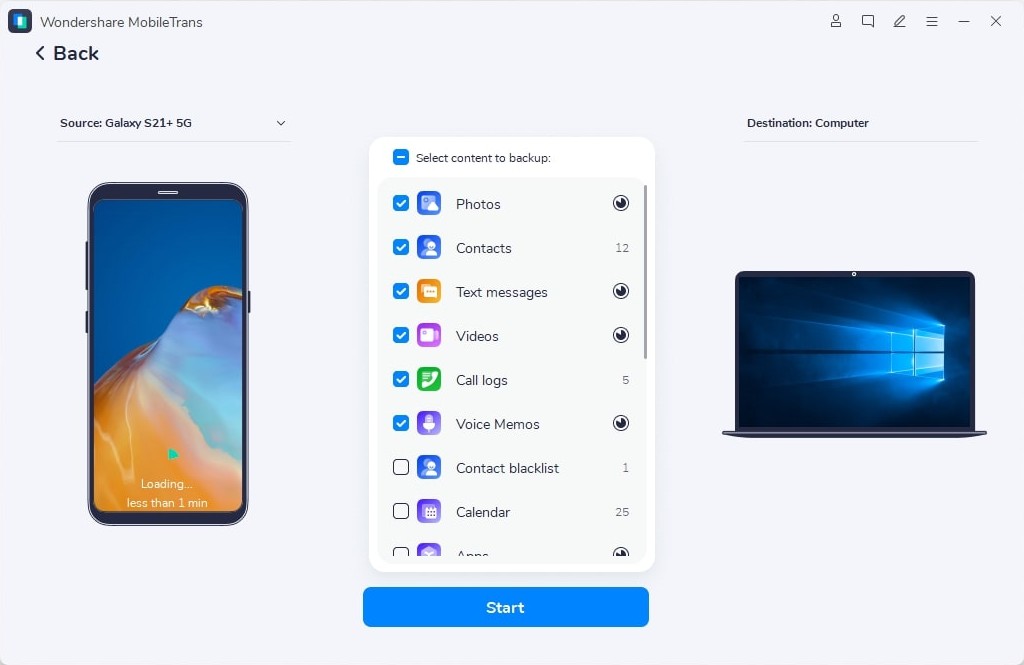- Where are iPad and iPhone backups stored on PC or Mac?
- Where is the iTunes backup folder on Windows?
- Where is the iTunes backup folder on macOS / OS X?
- How to find the iTunes backup folder automatically
- Opening the iTunes backup folder on Windows
- Finding the iTunes backup folder on macOS
- Changing the iTunes backup folder location?
- iTunes Backup Location: Where Does iTunes Store Backups?
- Part 1. where does iTunes store backups?
- 1. iTunes backup location windows 10
- 2. iTunes backup location windows 7
- 3. iTunes backup location mac
- Part 2: How to change the iTunes backup location?
- 1. How to change iTunes backup location Windows 10
- 2. how to change iTunes backup location windows 7
- Part 3: Backup iOS with MobileTrans – Backup
Where are iPad and iPhone backups stored on PC or Mac?
If you accidentally deleted some information from an iOS device and hope to recover it, an iTunes backup can be a great help.
iTunes backups happen automatically, each time you connect your iPad or iPhone with iTunes (if you didn’t turn on the iCloud Backup option), or manually, when you right-click the device in iTunes and choose ‘’Back Up’’. They are saved on your computer and contain important data, such as contacts, text messages, calendar, notes, call history and app data.
So where are iPhone or iPad backups stored? It depends on which operating system your computer is using, although the default backup location is the same between iOS versions.
Where is the iTunes backup folder on Windows?
iTunes backups are stored in %APPDATA%\Apple Computer\MobileSync on Windows.
On Windows 10, 8, 7 or Vista, this’ll be a path like \Users\[USERNAME]\AppData\Roaming\Apple Computer\MobileSync\Backup .
With Windows XP that’d be similar to \Documents and Settings\[USERNAME]\Application Data\Apple Computer\MobileSync\Backup .
The Microsoft Store version of iTunes is a little different: it stores its backups under %HOMEPATH%\Apple\MobileSync . That’ll be a path like \Users\[USERNAME]\Apple\MobileSync\Backup .
Where is the iTunes backup folder on macOS / OS X?
iTunes backups are stored in
/Library/Application Support/MobileSync on macOS.
That folder is typically at /Users/[USERNAME]/Library/Application Support/MobileSync/Backup .
In macOS 10.15, Finder creates iPhone backups, instead of iTunes. However, these backups are stored in the same location.
How to find the iTunes backup folder automatically
iPhone Backup Extractor automatically finds the iTunes backup folder for you, and can open it with a click. This functionality is in the free version, so this won’t cost a thing.
- Download and install iPhone Backup Extractor
- Open the Preferences window from the app’s pull-down menu
- Select the Backups tab.
- Where the window says «We always look for backups in your default folder», click the «default folder» link. Easy!

Opening the iTunes backup folder on Windows
Open the default Backup location in Explorer using the Windows Run command. Press ⊞ Win + R and the Run window should appear. Enter %APPDATA%\Apple Computer\MobileSync and press ⏎ Enter .
For the Microsoft Store version of iTunes, you could do this: Press ⊞ Win + R and the Run window should appear. Enter %HOMEPATH%\Apple\MobileSync and press ⏎ Enter .
Here’s what this looks like on Windows 10:

The Explorer window that opens will show a folder named «Backup». This contains any iTunes backups which are already present on the computer.
Finding the iTunes backup folder on macOS
The default backup location can be shown in Finder using Spotlight. Pressing ⌘ Cmd + and type
/Library/Application Support/MobileSync before pressing ⏎ Enter .
The Finder window that opens will show a folder named «Backup». This contains any iTunes backups which are already present on the computer.
Changing the iTunes backup folder location?
If you’d like to change the folder that iTunes backups up to by default, we have a handy guide in our support centre.
iTunes Backup Location: Where Does iTunes Store Backups?
Written By Axel Nash | Jun 19,2020
By default, Apple iTunes stores the backup on to the primary disk of your PC or Mac and doesn’t allow you to change the default backup location. iTunes backups are done automatically each time you connect your iPhone to iTunes and sync. These regular backups can take up several gigabytes on your system and therefore better to delete or move older iTunes backups. To find out the secret location where does iTunes store backups continue reading the piece.
Part 1. where does iTunes store backups?
iTunes backups are stored in different locations primarily based on the operating system.
1. iTunes backup location windows 10
On Windows 10 you can find your iTunes backup files in the MobileSync folder. Now, how to get to the mobile sync folder. Here’s the path
C:\Users\Your username\AppData\Roaming\Apple Computer\MobileSync\Backup\
Or
C:\Users\Your username\Apple\MobileSync\Backup\
You can also find the backups using the Windows Start Menu’s Search box. Here are the steps:
Step 1. In Windows 10 open the Start menu. Right next to the Start button you’ll see a search bar.
Step 2. If you downloaded the iTunes from Microsoft Store, click in the Search bar and enter %appdata%
Step 3. Or %USERPROFILE% and press Enter/Return.
Step 4. Once in the Appdata folder double-click the “Apple” folder and then “Apple Computer” and “MobileSync” and finally go to the “Backup” folder and you’ll find all your iTunes backups.
Note: If you aren’t able to find the backup folder this may be due to the AppData folder being hidden. You can change the settings by enabling “Show hidden files” in the Explorer settings and then repeat the procedure.
2. iTunes backup location windows 7
On Windows 7 you’ll find iTunes backup files in the MobileSync folder. Here’s how to get to the mobile sync folder. Here’s the path
C:\Users\Your username\AppData\Roaming\Apple Computer\MobileSync\Backup\
To locate the list of backups manually use the Windows Start Menu’s Search box. Here are the steps:
Step 1. In Windows 7 open the Start menu. Above the Start button you’ll find the Search bar.
Step 2. Click in the Search bar and type %appdata% and hit Enter/Return.
Step 3. Now open Apple Computer > MobileSync > Backup folders one by one.
Step 4. All the backup files will be in the folder just as in the image above.
3. iTunes backup location mac
To find the backups on your Mac device follow the steps
Step 1. Click on the search bar (magnifier icon) in the Finder menu or press the combo command of “Command + F” in the Finder window to search the location.
Step 2. You can also use the “Go to Folder” menu option in the Finder menu to jump to the location.
Step 3. Copy and paste or type this directory location:
Step 4. Here you’ll find all your iPhone and other Apple devices backups, with a jumbled up string of letters and numbers.
Step 5. You can also locate the files from iTunes (if macOS older than 10.15) or Finder if you’re using the latest macOS Catalina.
a. Go to iTunes and open preferences. In preferences click on Devices, right-click your device and then press Reveal in Finder. This will show the backups associated with the particular iPhone.
b. If using the latest Catalina, then head over to the connected iPhone under the Locations section in the Finder window. Here click on “Manage Backups”, Device backups window will pop up. Right-click on the backup file and press “Show in Finder”.
Part 2: How to change the iTunes backup location?
1. How to change iTunes backup location Windows 10
We will be using the symlink method – symbolic link to change iTunes backup location on Windows 10. The symlink is a new path for iTunes to get to the backups folder. Here I’ll show you how to use the Windows Command Prompt application to create a symbolic link that effectively tricks iTunes into backing up on to the new location you want.
You need to use the Windows Command Prompt to perform the finagling. I’ll take you through each step of the process.
Step 1. As we’ve already located the current iTunes backup directory, make a copy of the “C:\Users\Your username\AppData\Roaming\Apple Computer\MobileSync\Backup\” directory.
Step 2. Create a new directory wherever you want the iTunes to store all your backups from now on. For example, create a directory in C:\ folder.
Step 3. Go into the newly-created directory by using the “cd” command.
Step 4. Now navigate to the current backup location – “C:\Users\Your username\AppData\Roaming\Apple Computer\MobileSync\Backup\” using the Windows File Explorer and delete the backup directory and all its content.
Step 5. Head back over to the Command Prompt and type the same command: mklink /J “%APPDATA%\Apple Computer\MobileSync\Backup” “c:\itunesbackup”. Ensure to use the quotes.
Step 6. You’ve successfully created the symbolic link, a virtual connection between the two directories, and changed the iTunes backup location Windows 10.
Step 7. From now on new iTunes backups will go to “C:\itunesbackup” or the location you’ve defined.
2. how to change iTunes backup location windows 7
A symbolic link connects two folders, one serving as a proxy for the other. The linking is on the operating system level, so it works perfectly fine. We will use the same steps as we used for Windows 10. Employing the Windows Command Prompt to trick iTunes.
Step 1. Head over to the current iTunes backup directory, make a copy of the “C:\Users\Your username\AppData\Roaming\Apple Computer\MobileSync\Backup\” directory.
Step 2. Create a new directory wherever you want the iTunes to store all your backups from now on. For example, create a directory in C:\ “folder name”.
Step 3. Go into the newly-created directory by using the “cd” command.
Step 4. Navigate to the current backup location – “C:\Users\Your username\AppData\Roaming\Apple Computer\MobileSync\Backup\” using the Windows File Explorer and delete the backup directory and all its content.
Step 5. In the Command Prompt type the command: mklink /J “%APPDATA%\Apple Computer\MobileSync\Backup” “c:\itunesbackup”. Ensure to use the quotes.
Step 6. You’ve successfully created the symbolic link, a virtual connection between the two directories, and changed the iTunes backup location Windows 7.
Part 3: Backup iOS with MobileTrans – Backup
Wondershare MobileTrans can be used to easily and seamlessly create backups of all your iOS devices. This astounding piece of software is serving millions of people around the globe in resolving their problems with effectively any mobile operating system, from Android to iOS and Windows.
You no longer have to rely on the buggy and clumsy iTunes for backing up your revered data. Its continually updated with features and bug fixes to save you from facing any unforeseen situation. The company is always coming up with innovative and user-friendly technology solutions presenting state-of-the-art PC and internet-based applications.
MobileTrans – Backup and Restore can be used to
- • Backup and restore data from iOS, Windows, and Android devices.
- • The tool supports an extensive list of data file types and can backup music, videos, apps, photos, messages, wallpapers, ringtone, notes, reminder, bookmarks, calendar, and more.
- • It’s compatible with both Windows and Mac OS computers. And can backup and restore all major mobile devices i.e. iOS, Windows, and Android.
- • Backing iPhone using the polished and sleek MobileTrans tool is more convenient than iTunes or iCloud as it creates new copies of back up each time and won’t overwrite the previous backups.
- • The tool has been downloaded over 50 million times and supports over 6000 devices. It has an active 700 thousand premium customers.
- • MobileTrans allows you to select the type of content you want to backup and doesn’t back up everything from your device, saving storage space and time.
Let’s see how using MobileTrans you can back up your iOS devices easily.
Step 1. Download the MobileTrans – Backup and Restore tool and install it on your computer system either a Windows PC or a Mac and open it.
Step 2. Connect your iPhone, iPod, iPad, or any other iOS device to the computer system via a USB cable, the software will automatically detect and display the mobile on the MobileTrans window.
Step 3. Now choose the “Backup” option to the backup details.
Step 4. Inside backup you’ll see the extensive list of backupable content categorized based on content type. You can select the type of files that you want to back up from the iPhone to your computer system.
Step 5. Press the “Start” button. You need to make sure the device is charged and don’t disconnect the device during the backup process.
We effectively found the iTunes backup location and updated it successfully with the help of a symbolic link connection. I also introduced the best solution for you to back up any of your iOS devices – the MobileTrans backup and restore tool with the ability to backup selected types of files without any computer expertise and much effort. The procedure only requires two mouse clicks and is easier than the iTunes method of backing up the iPhone.





















